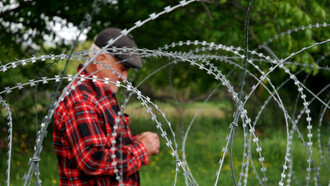I'm not fond of spiders. They freak me out with their hairy legs, multiple bulging eyes, fangs, jaws, and tiny claws. Fortunately, most spider faces are too small to see with the naked eye, but National Geographic keeps publishing close-up photos as if insects were centerfolds in Playboy. Mother Nature didn't intend for us to see insects that way.
But I faced the fear many years ago. Neighbors invited my wife and me to a birthday party for their six-year-old daughter. To give the kids a unique experience, the child's parents hired a local butterfly pavilion to bring in a collection of live reptiles, arthropods, and arachnids. One was a giant tarantula. Kids lined up for a chance to hold it.
Against my better judgment, I joined the line. When my turn came, the tarantula's keeper said its name was Millie and assured me that I needn't worry unless she reared up on her hairy hind legs. That would be a sign she was angry.
I held out my hand and received Millie. She was big enough that her face was clearly visible, like that of a terrifying lifeform from some other galaxy. I tried to bargain with her, saying, "I won't hurt you if you don't hurt me." But Millie seemed friendly. I stood stiff as a board while she crawled up my arm. When she got close to my face, the handler took her back, and that was that. I tell this story not only to brag about my bravery but also because it has something to do with the future of life on Planet Earth.
Sanctuary cities
The world's 10,000 cities are places where people take refuge from wild things. Except for an occasional park or green space, cities have spent considerable money to seal themselves from the Earth with concrete and asphalt, cut down trees, fill wetlands, and spray bugs.
"It may not feel as if you are in nature when you walk through a city, but you are," says journalist Nathanael Johnson. "All around you is a densely interconnected web of nutrient exchange, competing interests, and cross-species communication. There's an invisible world right in front of our noses, ready for exploration."
That world would be far more dynamic and visible if cities stopped depriving pollinators of access to wildflowers, blocking wildlife migratory routes, destroying wetlands, creating heat islands, and allowing runoff to pollute lands and waters or pollution to foul the air. But nature is irrepressible. Beneath the concrete and buildings, every hectare of soil contains 15 tons of living organisms, equivalent to the weight of 20 cows. In my book, The Creeks Will Rise, I describe what urbanites would discover if they practiced eco-mindfulness:
The next time you are outside, imagine that all the living things above, around, and below you, from microscopic to big, were making audible sounds. It would be an overwhelming biotic cacophony. When you walk across your lawn, be aware that a spoonful of the soil under your feet contains more busy microorganisms than people on the planet. Bacteria, actinomycetes, fungi, protozoa, and nematodes are at work, each with its own job. Earthworms are sliming around silently beneath the surface, multitasking as they aerate the ground, break down organic matter so plants can use it, and shed casings to fertilize the soil.
Among many other tasks, the hard-working trees inhale the CO2 you exhale and exhale the oxygen you inhale. Seven or eight of them produce enough oxygen to keep you breathing for a year. You are a player in the carbon cycle. Carbon dioxide moves continuously through plants, soils, the oceans, the atmosphere, and you.
Lately, some scientists have suggested that trees communicate with each other above and below ground. Fungal networks allow them to share water and nutrients and send alerts to other trees when they are in distress. The German forester who discovered this network calls it the "wood-wide web." You entered this biospheric world even before you stepped outside. When you showered this morning, you inserted yourself into the planet's water cycle. The water cascading down on you may have come from interstellar ice crystals older than the Earth and Sun. There is always the same amount of water in the biosphere, but it changes form. It may be ice one day, gas the next day, and the liquid coming through your showerhead the day after, but the amount of water is always the same. There will never be more or less of it on the planet.
Your breakfast cereal—in fact, half the food in the supermarket—would not exist without the help of pollinators like bees, butterflies, hummingbirds, beetles, and flies. With their assistance, fruits and flowers procreate in a process strikingly similar to ours. It's a bit startling to realize that the strawberries in your cereal bowl are actually the plant's ovaries protecting the seeds that contain the genetic code of its species.
Someday, when your heart stops beating, your body will slowly decompose into elements that are food for other organisms, and life in the biosphere will continue. Students of this process say there is an exception, however. A small part of us becomes helium that floats off into space, where it may be captured by the sun or another planet or where it leaves the solar system and drifts off into what the fearless space explorer Buzz Lightyear calls "infinity and beyond."
In the millisecond between life and death, you may discover the answer to the most mysterious question of all: Are we humans annuals or perennials? Until that time comes, we all bumble along through a miraculous, mind-boggling array of life serving us and the world around us with the knowledge it has refined through 3.5 million years of evolution.
These are the worlds from which cities separate us while creating air and water pollution, denying other species habitats, producing toxins, and sprawling into natural lands. Without different approaches to urbanization, the future doesn't look much better. Many of the world's cities didn't exist 40 years ago, but the United Nations estimates that 2.5 billion more people, or two of three worldwide, will inhabit cities by mid-century.
Instead, cities can be places where civilization and nature collaborate. Even in the most urbanized places, the goal should be productive harmony between humankind and nature.
Employing ecosystems
Among other things, this means reintroducing nature into cities. There are selfish reasons for doing so. We can think of many ecosystems as city employees who work for free, require no vacation time, and rarely call in sick. They are especially valuable in helping urban populations adapt to the sins of industrialization, including unhealthy air and water, diminishing supplies of fresh water, urban heat islands, floods, and other consequences of climate change. These problems are costly in terms of wealth as well as health. The World Meteorological Association says weather disasters have caused an average of more than $200 million in damages every day over the last 50 years.
Urban flooding is an example. Floods are the most common weather-related disasters in Europe and the United States. Record rains become flash floods when concrete, asphalt, and buildings cause runoff. Green spaces like parks and meridians can absorb as much as 80 percent of the rain that falls on buildings. When they stop rain where it falls, permeable surfaces recharge groundwater. Trees absorb water, too—each conifer can reduce stormwater runoff by 4,000 gallons annually.
Cities that employ these ecosystems to reduce or prevent floods are called "sponge cities." They also cut the costs of mechanical stormwater controls, and they don't wear out. In the United States, for example, aging mechanical systems will require an estimated $67 billion in repairs and replacements over the next two decades.
Heat is another example. It is the deadliest weather in much of the world, and Europe is the fastest-warming continent. Over 61,000 people died from record heat there during the summer of 2022. A study published by the World Economic Forum estimated that green vegetation in large metropolitan areas could have saved as many as 38,000 lives in the United States between 2000 and 2019. Cities can also address broader ecological concerns. Wildlife corridors give animals safe passage as they migrate or permanently relocate from unlivable places because of climate change or human development.
Some of the most important but least appreciated benefits of urban ecology are psychological. Nature has proven healing powers. The American Psychological Association confirms that contact with nature reduces stress, improves sleep, brightens moods, quiets negative emotions, encourages more social interaction, and "generates a sense of meaning to life." Incorporating nature in and around workplaces has been found to improve. One writer calls nature a "balm for our busy brains."
Biophilia and Its evil twin
Many cities and international groups are mobilizing to rewild cities and countries. In the 1980s, the late biologist E.O. Wilson introduced the idea that people are drawn to nature. He promoted "biophilic" cities that incorporate species habitat and ecosystems. His concept has expanded into a global network of cities that marry biophilia with urban life. So far, cities in Canada, the United States, the UK, Spain, and Costa Rica are working to be biophilic by introducing nature in parks, traffic circles, median strips, greenbelts, and even alleys.
In 2022, representatives of 188 governments agreed that "nature-positive" actions would save enormous amounts of money and lives. The World Economic Forum co-sponsors a program called BiodiverCities by 2030 to help cities live in harmony with nature by the end of this decade. In 2021, G7 leaders created a Nature Compact to reverse biodiversity loss worldwide by 2030.
But to be more than good intentions, the movement must overcome long-standing fears and attitudes. Graham Lawton, a writer for New Scientist magazine, reports that despite the natural affinity between humans and nature, some people suffer from biophobia, the fear of wild things. Others detach. Lawton warns of a "shifting baseline" where people become so detached from nature that they consider it little more than weeds in an abandoned parking lot.
While the world appears to be awakening to a fundamental reality—the well-being of people and nature is profoundly interconnected—we continue separating the two kingdoms in our laws and economics. Some critics point out that the UN's separate COPs on climate and biodiversity seem to reinforce the perception that human problems are one thing and nature's another.
Ecologist Heather Alberro believes that ecological breakdown is a predictable result when we subconsciously assume that we are separate from nature. She points out that even terms like natural capital suggest "the Earth's fabric holds no value apart from what it provides us. That leads us to exploit it recklessly."
It may not occur to us that cities have a role in a global rewilding plan, but they must. Rewilding the countryside is only half of it," Graham Lawton points out. "We need to rewild ourselves, too." I understand this now. I've felt a little wilder myself ever since I made friends with Millie.














